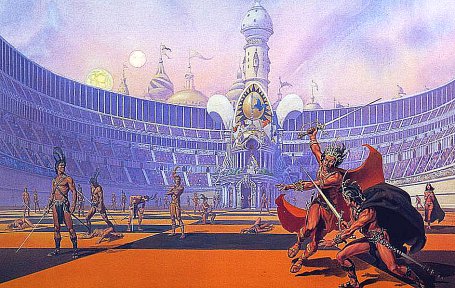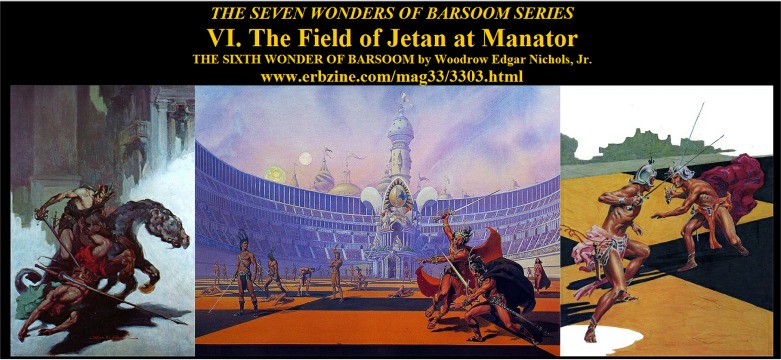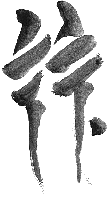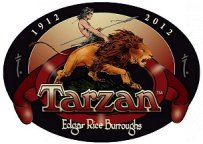
First and Only Weekly Online Fanzine Devoted to the Life and Works of Edgar Rice Burroughs Since 1996 ~ Over 15,000 Web Pages in Archive presents Volume 3303 |

First and Only Weekly Online Fanzine Devoted to the Life and Works of Edgar Rice Burroughs Since 1996 ~ Over 15,000 Web Pages in Archive presents Volume 3303 |
|
VI. The Field of Jetan at Manator 
by Woodrow Edgar Nichols, Jr.
Even though there is no doubt in my mind that this book should have been called Tara of Helium, the book’s actual title, The Chessmen of Mars, brings us to the Sixth Wonder of Barsoom, the Jetan Playing Field of Manator. Playing Jetan, or Martian Chess, is one of Barsoom’s favorite pasttimes, for it exemplifies the whole politico-socio aspect of Martian culture: the abduction of another kingdom's princess and the wars that inevitably follow. Not only does ERB introduce us to the game of Martian Chess in this book – giving us the rules in the appendix – he also gives us a real-life practical demonstration in the combination of moves that became famously known as the Gatholian Gambit: forget the subtle play of strategy, it's time to clear the field for the main match: Chief vs. Chief! The city of Manator is built around a gigantic amphitheater formed around an actual Jetan Board of one hundred orange and black squares laid out on the huge playing field, known as the Field of Jetan. Normally, chess is played by taking opposing pieces, that is, when one piece lands on the same square of an opposing piece, the opposing piece is taken automatically. However, on the Fields of Jetan, when a piece occupies the square of an opposing piece, the square is contested in combat. A combination of chess and gladiator sport: who could ask for a better game? We will now examine the Field of Jetan in detail and then analyze the facts so as to get an idea of how this amphitheater would have appeared on Barsoom, thus justifying its listing as the Sixth Wonder of Barsoom. My favorite artistic depiction is that of Michael Whelan. (See Erbzine #1351.)
A. The Rules. Here are the rules ERB gave for the play of Jetan, as they appear in the appendix to The Chessmen of Mars: “THE BOARD: Square board consisting of one hundred alternate black and orange squares.Of course, as ERB demonstrates in this story, these rules would be called "The Helium Rules," for in Manator, as we shall see, the game is played with different pieces and rules.
B. The Location, Construction, and Play of The Field of Jetan: We learn from bits and pieces, that the stadium is towards the center of the city, and how it is constructed: “Outside the palace, Ghek and Tara of Helium were separated. The girl was led through long avenues toward the center of the city and finally into a low building, topped by lofty towers of massive construction.” (CMM/11.)We learn that the lofty towers of massive construction are called the Towers of Jetan, one of them being named the Thurian Tower, which Tara learns from Lan-O, the slave girl: "Tara of Helium sat erect and looked about her. This rough stone was not the marble of her father’s halls. ‘Where am I?’ she asked.Later, Tara once again seeks knowledge from Lan-O: “‘What are the games? I do not understand,’ said Tara. ‘I have heard them speak of playing at jetan, but surely no one can be killed at jetan. We play it often at home.’They are interrupted by a group of guards looking for the keeper of the tower whom Tara has stabbed to death with her dagger and hidden the body with the aid of Lan-O. After they leave, they are disturbed by a tumult outside a window: “And after they had gone Tara stood for long looking out upon the city of Manator, and wondering what more of cruel wrongs Fate held in store for her. She was standing in silent meditation when there rose to her the strains of martial music from the city below – the deep, mellow tones of the long war trumpets of mounted troops, the clear, ringing notes of foot-soldiers’ music. The girl raised her head and looked about, and Lan-O, standing at an opposite window, looking toward the west, motioned Tara to join her. Now they could see across the roofs and avenues to The Gate of Enemies, through which troops were marching into the city.” (CMM/13.)When Tara was first captured and brought into the city, U-Dor, her captor, took her into the city through the Gate of Enemies, down a long broad avenue that opened into a square before the Palace. This gives us an approximate idea of the location of the arena vis-a-vis the Gate and Palace. Gahan of Gathol, aka Turan the Panthan, signs up for the games under yet another name, this time U-Kal of Manataj. He signs up as a volunteer to play for Tara of Helium. The clerk protests: “‘But man, she is to be the stake of a game for slaves and criminals,’ cried the keeper. ‘You would not volunteer for such a game!’Turan convinces the keeper that the others can be reasoned with if he makes him the Chief of the Blacks and gets to chose his players from among those prisoners from Gathol. His request is granted, and one of the first players he selects is Val Dor of Helium. It is here that Turan learns one of the main variations of Manatorian jetan: “‘How could I know aught of Helium?’ asked Turan; ‘but if you be such a fighter as you say no position could suit you better than that of Flier. What say you?
C. The Game Played: the Gatholian Gambit: Turan takes the field as the Black Chief against U-Dor, who has foolishly volunteered so that he too may possess Tara of Helium and Lan-O. Turan meditates on the strategy of the game: “The vital difference between the game played with living men and that in which the inanimate pieces are used, lies in the fact that while in the latter the mere placing of a piece upon a square occupied by an opponent piece terminates the move, in the former the two pieces thus brought together engage in a duel for possession of the square. Therefore there enters into the former game not only the strategy of jetan but the personal prowess and bravery of each individual piece, so that a knowledge not only of one’s own men but of each player upon the opposing side is of vast value to a chief.The keeper of the Towers announces the second game for the day and the stakes:
“Once she saw Gahan glance quickly up toward the sinking sun. In thirty minutes it would be dark. And then she saw and all those others saw a straight transition steal over the swordplay of the Black Chief. It was as though he had been playing with the great dwar, U-Dor, all these hours, and now he still played with him but there was a difference. He played with him terribly as a carnivore plays with its victim in the instant before the kill. The Orange Chief was helpless now in the hands of a swordsman so superior that there could be no comparison, and the people sat in open-mouthed wonder and awe as Gahan of Gathol cut his foe to ribbons and then struck him down with a blow that cleft him to the chin.” (CMM/17.) ANALYSIS
The arena is composed of a low building surrounded by lofty towers of massive construction, and it appears safe to imagine at least four towers, one for each side of the playing field. In the center of the low building-tower complex is the playing field, surrounded by several tiers for spectators. Tara first sees it looking out an east window in the Thurian Tower, thus we can imagine the four towers midway on each side of the field. We are told that the opposite window looks out at the Gate of the Enemies, so we are fairly certain that the Thurian Tower lies midway on the western side of the playing field if it is laid out with the Black player on the south side of the field and the Orange player on the north side. If the game is set up like traditional chess, where a white square is always in each player’s right hand corner, then a black or orange square should be at each player’s right hand corner. The respective positions of the pieces would thus only
apply to the initial positions of the Black player, for if the board is
set up like traditional chess, the positions of the first row for the Orange
player are going to have the Chief and Princess reversed. We are told that
Gahan of Gathol has the Black pieces, and that when they take their places
on the field:
“At Tara’s left was the Black Chief, Gahan of Gathol; directly in front of her the Princess’ Panthan, Floran of Gathol; and at her right the Princess’ Odwar, Val Dor of Helium.” (CMM/17.)Thus, we learn that in ERB’s rules for the game the placement of the pieces is from the Black side's perspective, for from left to right you have the Chief and then the Princess. For the Orange side, the sequence is reversed – Princess then Chief. In other words, for the Black side, the Princess is always to the Chief’s right hand side, whereas for the Orange side, the Princes is always to the Chief’s left hand side. This is necessary to grasp, for otherwise ERB’s descriptions of U-Dor’s moves for the Orange pieces appear to be backwards. Thus, U-Dor’s first move, moving his Princess' Odwar three squares diagonally to the right, means U-Dor’s right. It would be to the left from Gahan's perspective. U-Dor’s second move, moving this same Odwar three squares diagonally to the left this time, means again his left. Since this Odwar has the same moves as the Flier, it can jump over either the Princess’ Panthan, or her Odwar's Panthan, and seize the Princess in its next move if uncontested. U-Dor's next two moves only makes sense if he used his one time only ten square move called "the escape" for the Princess. This is because in only two moves, he has moved Lan-O's Odwar's Panthan one square forward, and Lan-O four squares to the left and three forward, or three squares forward and four to the left from his perspective. This means that a creative straight and diagonal combination would have had to been made – jumping over pieces and avoiding landing in any square more than one time in a single move – to make up for ten squares. The Princess may move normally in one move no more than three squares, while the one she was on was seven squares away, too many for one move. This can be easily seen if the reader sketches out a jetan board and follows the play by play. To properly grasp the size of the playing field, it seems reasonable to imagine each square being thirty feet by thirty feet, for you would at least need that much room if you were fighting on Thoats. This would make the Field 300 feet by 300 feet, or a squared football field. Thus, unlike modern football stadiums that are more oval than round since the field is rectangular, the Field of Jetan arena would be more likely be round or a in the shape of a square. And there you have it:
THE SEVEN WONDERS OF BARSOOM SERIES 7 WONDERS: I | II | III | IV | V | VI | VII RUNNERS UP: I.a
| II | III
| IV | V
| VI | VII
| VIII.2.2b.3a.3b
| IX | X.2.3.4
|

.
WEB REFS
www.johncarterofmars.ca
A Princess of Mars
Gods of Mars
Warlord of Mars
Thuvia, Maid of Mars
Chessmen of Mars
Mastermind of Mars
A Fighting Man of Mars
Swords of Mars
Synthetic Men of Mars
Llana of Gathol
Skeleton Men of Jupiter
John Carter and the Giant of Mars


BILL HILLMAN
Visit our thousands of other sites at:
BILL AND SUE-ON HILLMAN ECLECTIC STUDIO
ERB Text, ERB Images and Tarzan® are ©Edgar Rice Burroughs, Inc.- All Rights Reserved.
All Original Work ©1996-2011/2017 by Bill Hillman and/or Contributing Authors/Owners
No part of this web site may be reproduced without permission from the respective owners.
www.johncarterofmars.ca
www.cartermovie.com